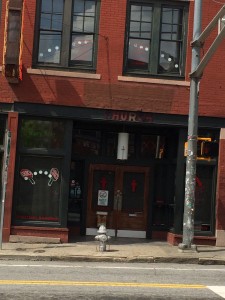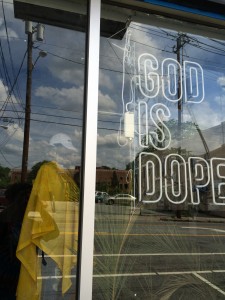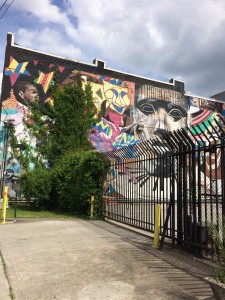The city of Atlanta, and its surrounding metropolitan cities, are home to many creative, urban youths. Natives of these communities have pioneered several popular dance crazes, fashion trends, and viral rap songs through the help of the internet. In fact, it seems as if the majority, if not all of the newest fads are first spotted in Atlanta these days. The argument can be made that it is not a coincidence but more of a consequence, if you will. In fact, the city of Atlanta has an undeniably strong influence on the music industry these days, particularly the hip-hop and R&B genres. The built environment of areas such as Edgewood Avenue, East Atlanta Village, and Little Five Points have a cause and effect relationship with the prominence of successful music artists that sprout from the city. These areas have unique vibes all given off by the culture that grows from them. Straight, long boulevards that are narrow and easy to cross without stoplights lead to clubs and bars made of all brick that are fully dressed in spray paint, and vibrations from the exclusive new music being performed by the next big rap star upstairs.
Edgewood Avenue, perched on the eastern side of downtown, is easily one of the most culturally influential streets in the whole southeastern United States. The street, which stretches through several neighborhoods, features some of the most active hip-hop clubs and bars in the city. Nowadays, Atlanta is recognized as the hip-hop capital of the world as 26% of the artists currently charted on the Billboard Hot 100 are either from Atlanta or began their musical careers in the city. One place where independent musical artists can get their start is a club posted on Edgewood known as The Department Store. Department Store does not look like a department store, nor does it look like a hip-hop club. It’s skinny, tall brick build resembles more of a tower, or even a warehouse. The venue is two stories, and features windows among the top floor where one can see the crowd packed in to see the show, or even the performer from the street level outside. Having windows that open up to the Atlanta night skyline not only allow spectators inside to have a scenic view, but also makes for the music to be more coherent and enjoyable even from outside. That specific feature enables young people who are under 21 and ineligible to enter the venue enjoy the music and receive inspiration from it as well. This allows for performers to build a fanbase larger than the room itself, but grab the attention of those walking Edgewood Ave casually as well. For example, rapper ILoveMakonnen, who is currently signed to Warner Bros. Records was discovered by an engineer for the company while performing inside Department Store and being heard by the near-by executives who were partying elsewhere on the strip. The road itself on this particular part of Edgewood is very narrow which allows for party-goers to j-walk freely across the street that is not very busy with cars.

View from outside Department Store
Another factor of Edgewood’s built environment that enables it to remain relevant on the national rap scene: its close neighboring to Georgia State University. Georgia State’s campus shares Edgewood with the rest of the hip-hop world. A campus dining hall sits one half mile from Department Store and Church Bar. This physically close relationship is what enables the youth of the city who may be limited transportation wise to stay involved in the scene and share their music with the world. In 2013, a dance titled “Nae Nae” swept the nation as even first lady Michelle Obama couldn’t help herself from busting out the dance move. The highly popular dance was created by WeAreToonz, a musical group that doubled as Georgia State Students at the time of their breakthrough.
Pedestrians who want to escape the loud performances of Department Store skip across the street to a another club with unorthodox physical characteristics; Church. Church is a bar titled misleadingly with signs that claim it is not a bar at all. Once again, the all brick, block build is not quite synonymous with that of a bar, however there is nothing reminiscent about this venue at all. From across the street, creative paintings of Martin Luther King Jr. and Jesus are visible inside the bar. Depictions of two figures of such, especially in Atlanta, Georgia are usually taboo unless it is with respect. Although the creativity and rule bending of the Church bar is not meant to offend anyone, it often does. However, the average Edgewooder welcomes anything that is out of the ordinary. It is almost impossible to not come up with new ideas, dance moves, and slang when one is partying to rap music and drinking alcohol in “church.” Creative and edgy places like Department Store and Church promote the harvesting of new ideas through their contradictory names and controversial nature. Physically, the two popular spots are very close to one another which allows for party hopping and spreading of new trends quicker.

View from across the street of Church Bar, crosses on the door are visible
A short walk down the road is a small building commonly used for retail sales of independent clothing lines. The inside of the building is no larger than a two car garage which only allows for a small amount of customers to enter at one time and only a small amount of product. The small stature of the room is appropriate because it is easier for a group of people to collect their belongings and vacate the shop in time for the next person to be able to sell his/her clothes the next night. Because the building is so small only start up brands by beginning fashion designers with only a few different styles for sale can set up there. The inability for a big business to take up that shop on Edgewood inspires everyday people who want to sell clothes to begin designing due to the fact that they will have somewhere to begin to get exposure at. The low accessibility and awkward location makes the shop undesirable to big clothing brands and passes down the usage to the young, urban creatives of Edgewood. This is where new fashion trends are made before being posted on the internet and become nationwide phenomenons among the youth. From that very building is where the brand “God is Dope” currently is stationed. The young adults behind the brand began selling them on the campus of Clark Atlanta University before taking to Georgia State and Edgewood. These days God is Dope can be seen worldwide from being worn on stage by rappers to making appearances on the wardrobes of stars of Love and Hip Hop Atlanta ; a national reality television show that spoon feeds the rest of the country even more of Atlanta’s hip hop subculture.

God Is Dope Pop up shop window, Edgewood Ave NE
Additionally, Little Five Points, a shopping area on the east side of the city, is a breeding ground to originality by design. Moreland Avenue trails quietly into the area filled with colorful scenery to match the colorful people that inhabit the space. Brick buildings with alleyways allow for creative photo and video shoots in front of the art plastered in the background. The buildings themselves are home to unorthodox shops full of rare products that are almost impossible to find anywhere else. The famous “Criminal Records” sign heads a shop full of record players and vintage records that are widely extinct at this point. However the business survives as if it is not the last of a dying breed. Why? The people that regularly shop there are influenced by the culture supported by the built environment. Due to the large popularity of the area, many big time artists are spotted taking pictures with fans and doing promo runs. As popular as the area is, it is mostly crowded with “hipsters” or people who are on to new music and trends before anyone else. Which is why popular rappers can walk through the area without being swarmed as much as he/she would anywhere else. The commonness of rap artists intermingling with the trendsetters of the city further deepens the culture as the hip hop industry continues to thrive in Atlanta. People in Atlanta attend 25% more rap concerts than residents of any other city in the world. That statistic can be traced back to the “homecrowd effect” as most rappers these days are from Atlanta which means performing here caters to the artist’s main fanbase, or it can be attributed to something else such as the amount of concerts held in the city. More rap concerts are held in Atlanta than anywhere else, partially because of a 5-day long gathering of the hottest artists in the industry held in the center of downtown known as A3C.

Buildings built on Edgewood as this one allow for street art that photoshoots and music videos use for backdrops

Pole on Edgewood Ave covered in flyers for open mic nights and performances in Department Store and around the city

A unique music shop, as per usual in L5P and Edgewood
As thoroughly connected as the culture is with Edgewood and little five points, it runs even deeper throughout the city than just that. The A3C hip-hop music festival held in Atlanta is the most popular of its kind. Held annually, the festival is the intersection of the mainstream and independent music industries. The built environment of Atlanta is significant in acting as a good host city for the conference as the city allows for a few different transportation options when it comes to navigating the conference. Atlanta has recently built rails into the ground of a string of streets to operate the Atlanta Streetcar. During the A3C festival, it is free to ride the Atlanta Streetcar to get around to the site of your choice. This built factor of the city ties the hip hop community together by bringing mainstream music professionals such as artists, producers, and engineers who are from out of town and do not know their way around the city on the streetcar along with independent musicians who are trying to network and make a name for themselves. The purpose of the A3C festival is for up and coming hip-hop artists and talents to be discovered and to promote those who are already popular. Factors such as the roads built for Atlanta Streetcar ensure that the festival is successful in that mission.
To conclude, the built environment of particular sections of the city of Atlanta promote forward thinking in the youth in several ways. Atlanta can almost be viewed as a dry erase board that every generation erases and starts fresh with. This generation has filled the city with new undertones of culture that can be looked at as an effect of the built environment. Atlanta has its hand over the hip-hop industry and culture: formally and informally. From the annual BET hip-hop awards, to the open mic nights on Edgewood, everyone is watching the city to see who or what is coming next. There are young people in every city, there are rappers and every city, what makes Atlanta special and brings the two together is the built environment. In simplest terms, the built environment is the reason why Atlanta in 2016 is reminiscent of San Francisco in 1849. The youth, however do not come here for gold, they come for hip-hop.
Works Cited
“2015 A3C Festival & Conference [MAP].” 2015 A3C Festival & Conference [MAP]. N.p., 15 Jan. 2016. Web. 29 Apr. 2016.
Nielson, Local. “Atlanta Statistics and Market Research.”Scarborough.com. Nielson Local, 7 Apr. 2016. Web. 26 Apr. 2016.
“Rap Music: Top Rap Songs Chart | Billboard.” Billboard. N.p., 20 Apr. 2016. Web. 26 Apr. 2016.






